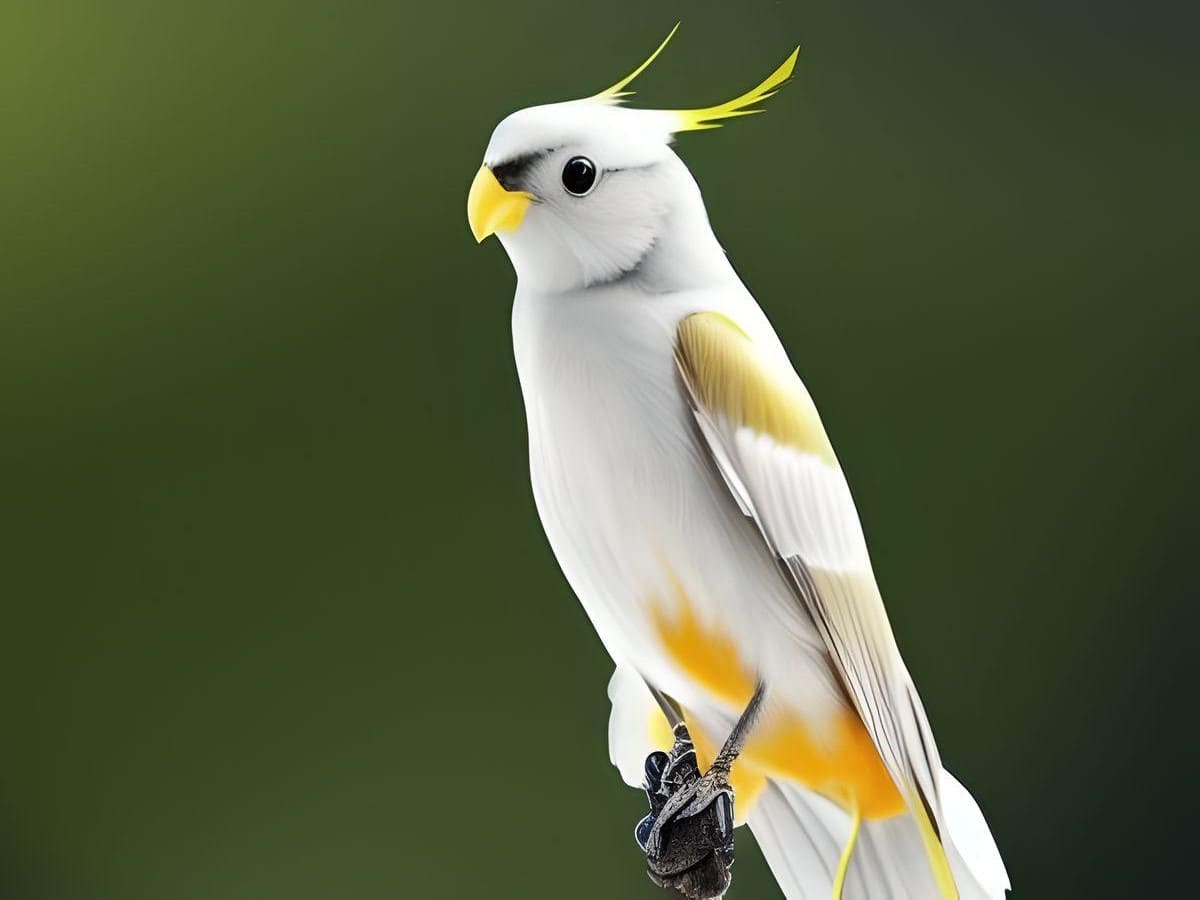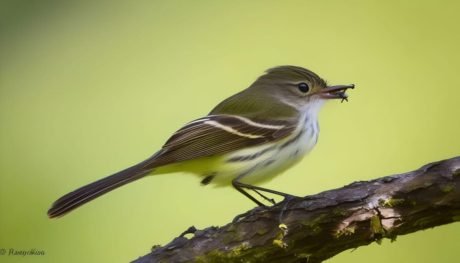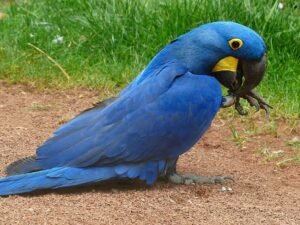Cockatiel Bird | Characteristics, Price, 15 Type, Care Tips, Facts, Health Issues
Step into the captivating world of Cockatiel birds – delightful companions known for their vibrant personalities and unique traits. Whether you’re an avian aficionado or new to the bird-keeping realm, this article unveils the wonders of Cockatiel Birds. Discover their diverse colours, endearing behaviours, care tips, and the joy they bring to countless homes. Join us in exploring these enchanting creatures that have nestled their way into the hearts of bird enthusiasts worldwide.
Cockatiel Bird
Origins and Appearance:
Native to Australia, cockatiel birds (Nymphicus hollandicus) are a small member of the parrot family. Their captivating appearance includes a beautiful crest that elegantly adorns their heads and a vibrant range of colours that vary from soft grays and whites to vibrant yellows and oranges. This stunning plumage is not only a visual treat but also serves a purpose, allowing them to communicate their emotions and moods.
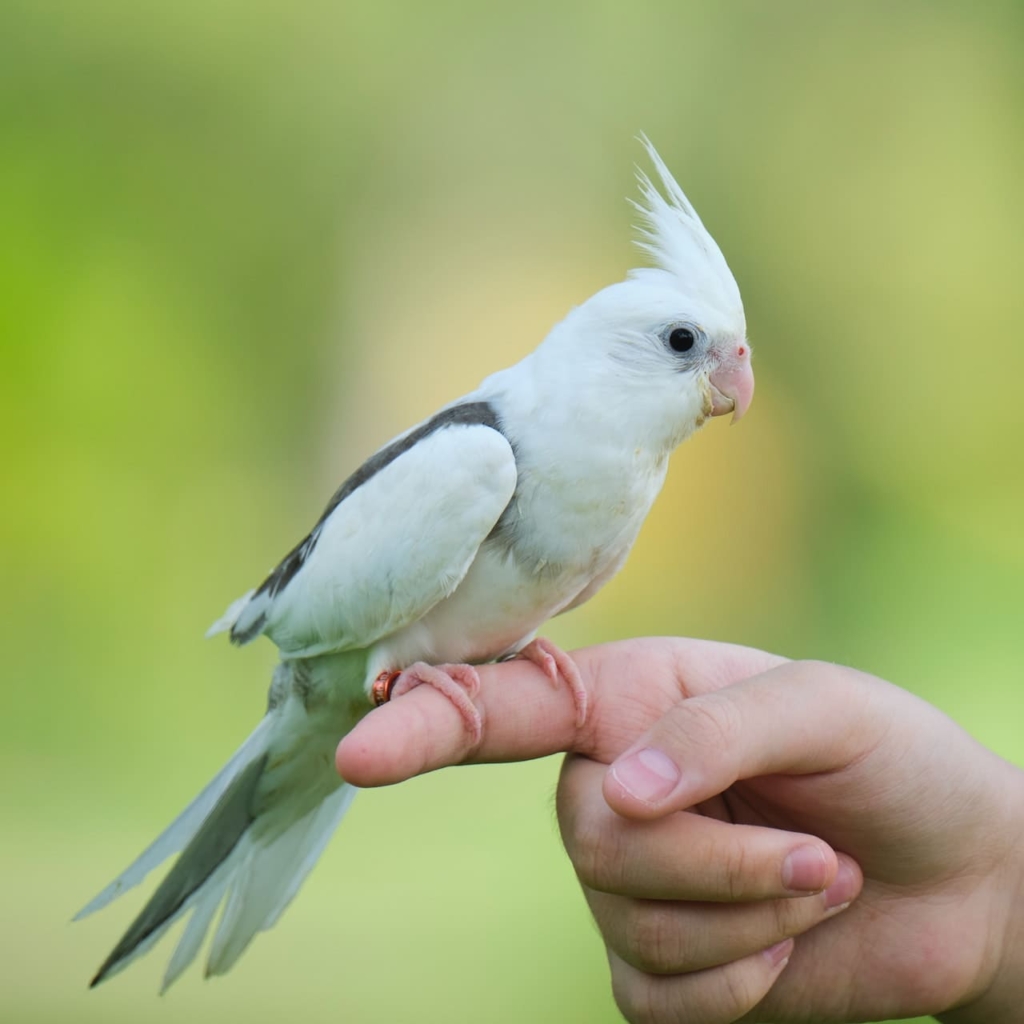
Charming Personalities:
One of the most endearing qualities of cockatiel Birds is their charming personalities. These birds are known for their playful and affectionate nature. They often form strong bonds with their human companions and enjoy interacting through whistles, chirps, and even the occasional head bob. Their inquisitive demeanour and ability to mimic sounds add an element of entertainment to any household.
Melodious Serenades:
If you’re a fan of soothing melodies, a cockatiel Bird’s musical repertoire might just captivate you. These talented birds are accomplished singers, capable of producing a wide range of tunes. From cheerful chirps to more complex melodies, their songs can brighten up your day and create a harmonious atmosphere in your home.

Caring for Your Cockatiel:
Creating a happy and healthy environment for your cockatiel Bird is essential. Provide a spacious cage with plenty of room for them to spread their wings, along with toys that stimulate their curiosity. A balanced diet of high-quality pellets, fresh fruits, and vegetables will ensure their nutritional needs are met. Regular interaction and mental stimulation are key to keeping your cockatiel engaged and content.
Baby Cockatiel
Welcoming a baby cockatiel into your home is an exciting journey filled with adorable moments and new experiences. These tiny bundles of feathers require special care and attention as they grow into charming companions. From creating a cozy habitat to providing the right nutrition, raising a baby cockatiel Bird is a rewarding endeavor.
Caring for baby cockatiels begins with a well-equipped cage, complete with soft bedding and plenty of perches for their tiny feet. Offering a balanced diet rich in nutrients is essential to support their rapid growth. Gradually introduce them to new foods and provide fresh water daily.
Lutino Cockatiel
Lutino cockatiel Birds are a sight to behold with their striking appearance and captivating charm. These beautiful birds boast a soft, alluring plumage that lacks the typical gray markings of their counterparts. Instead, their feathers showcase vibrant yellow and white hues, creating a truly unique aesthetic.

Lutino cockatiels, like all cockatiels, thrive on social interaction and mental stimulation. Keep them engaged with a variety of toys and activities to prevent boredom. A balanced diet, which includes seeds, pellets, fruits, and vegetables, will keep their health in check.
Whether they’re whistling sweet tunes or simply basking in their natural beauty, Lutino cockatiel Birds make wonderful companions for those seeking a feathered friend that’s as enchanting as they are elegant.
Albino Cockatiel
Albino cockatiel Birds exude an air of mystery with their snow-white plumage and captivating red eyes. These birds are a true marvel of nature, displaying a rare genetic mutation that eliminates all pigment from their feathers, beak, and even their eyes.
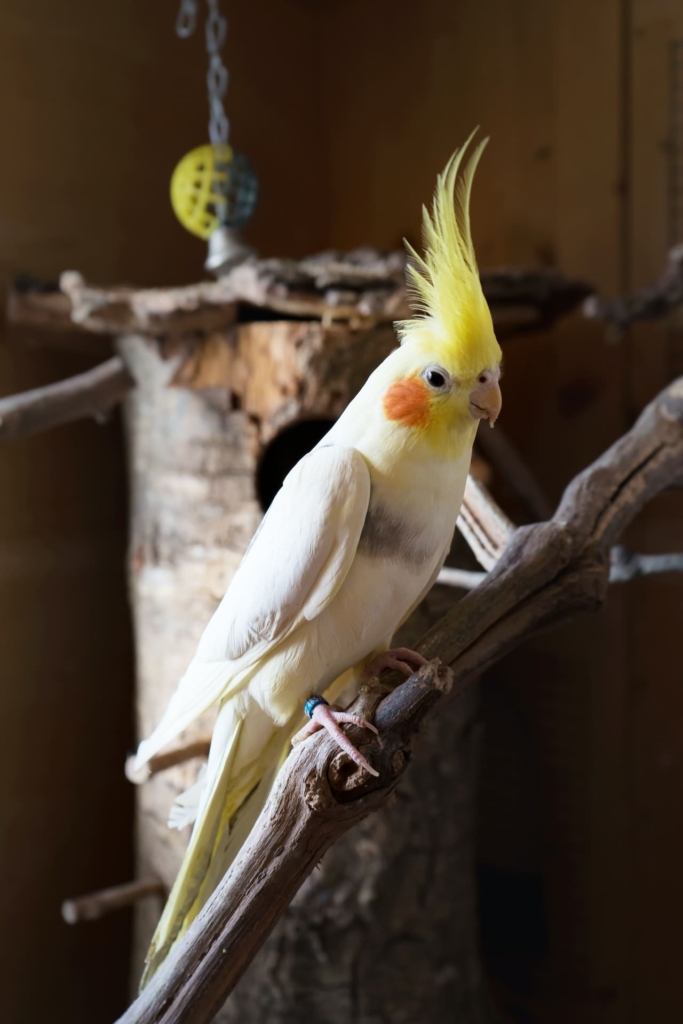
Caring for an albino cockatiel requires a touch of extra attention. Due to their sensitive eyes, they’re more susceptible to bright lights, so provide shaded areas in their cage. Grooming is essential to maintain their pristine appearance, and a varied diet rich in nutrients will ensure their well-being.
Albino cockatiel Birds may be unique in appearance, but they share the same playful personalities and love for interaction as their counterparts. As you embark on this journey of companionship, you’ll be enchanted by their grace and elegance.
Wild Cockatiel
The wild cockatiel, native to the vast landscapes of Australia, embodies the untamed spirit of the outback. With their subtle gray plumage adorned with intricate patterns, these birds showcase nature’s artistry in every feather.

Observing wild cockatiel Birds in their natural habitat is a humbling experience. They thrive in flocks, socializing and foraging together. Replicating their natural behaviors in captivity is essential for their well-being. Provide a spacious cage, encourage flying, and offer a diverse diet that mimics their wild food sources.
While wild cockatiels may retain a touch of their untamed essence, with patience and understanding, they can become captivating companions, offering a glimpse of the wild world they call home.
Cinnamon Cockatiel
Cinnamon cockatiel Birds are a warm and inviting variation of these beloved avian companions. With their soft cinnamon-hued feathers, they exude a sense of coziness that’s hard to resist. This color variation is a result of a genetic mutation that affects the distribution of pigment in their plumage.

Cinnamon cockatiels share the same charming personalities as their counterparts, with a penchant for playful interactions and melodious songs. Their care requirements are similar to other cockatiel Birds, including a spacious cage, a balanced diet, and regular mental stimulation.
Adding a cinnamon cockatiel to your home is like embracing a warm and comforting presence that adds a touch of natural beauty to your daily life.
Australian Cockatiel
The Australian cockatiel, hailing from the vast and diverse landscapes of its homeland, is a living testament to the beauty of Australia’s wildlife. With its distinct crest and enchanting plumage, this bird has captured the hearts of avian enthusiasts around the world.

Native to the arid regions of Australia, these cockatiel Birds are well-adapted to their environment. When caring for an Australian cockatiel, consider providing a spacious cage and maintaining a consistent temperature. Their diet should mimic their natural food sources, with a mix of seeds, pellets, and fresh vegetables.
Bringing the essence of Australia into your home through an Australian cockatiel Bird is a rewarding experience that allows you to appreciate the captivating diversity of our planet’s avian inhabitants.
Pied Cockatiel
Pied cockatiel Birds are a delightful mosaic of colours that bring an extra dose of playfulness to the world of cockatiel companionship. Their unique plumage is characterized by patches of different colours, creating a captivating and whimsical appearance.
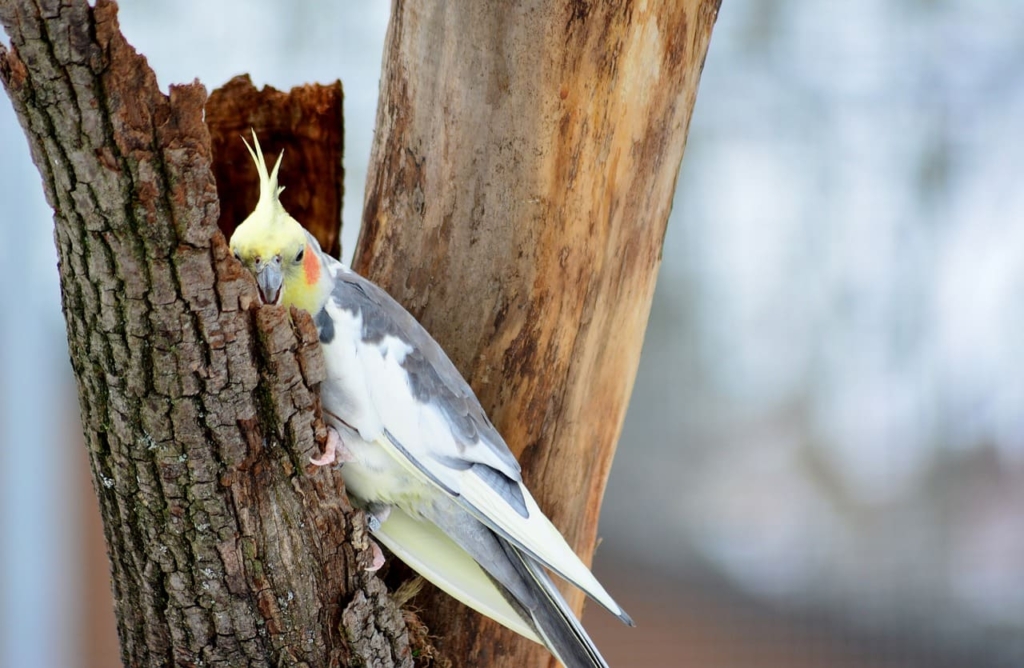
The charm of pied cockatiels extends beyond their looks; they possess the same friendly and inquisitive personalities that make cockatiel Birds cherished companions. To care for your pied cockatiel, provide a spacious cage, engage in regular interaction, and offer a balanced diet to ensure their health and happiness.
Bringing a pied cockatiel into your life adds a splash of vibrant personality to your home, enriching your days with their cheerful presence.
White Faced Cockatiel
White faced cockatiel Birds, with their pristine white visages and contrasting dark eyes, radiate an air of elegance that’s hard to overlook. This unique coloration sets them apart from their peers, showcasing a beauty that’s both striking and graceful.
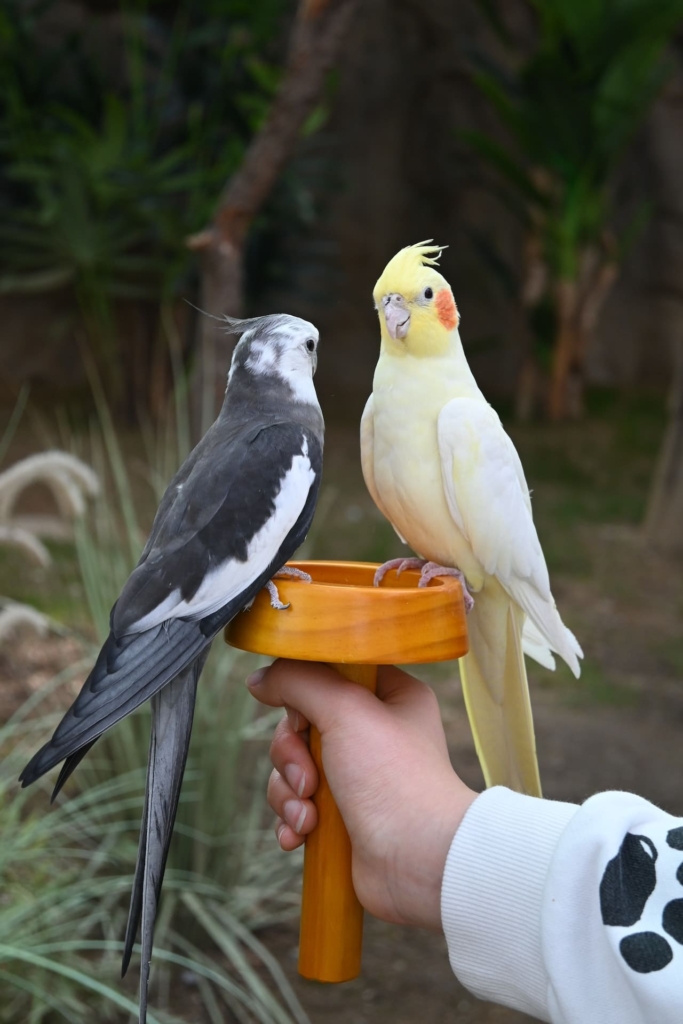
Caring for a white faced cockatiel involves providing an environment that stimulates their intellect and satisfies their social nature. Offer a variety of toys, encourage mental engagement, and provide a diet that caters to their nutritional needs.
White faced cockatiels are a reminder that beauty comes in many forms, and their presence in your home adds a touch of sophistication to your avian companionship.
Ashenfallow Cockatiel
Ashenfallow cockatiel Birds are a captivating variation that showcases an understated yet mesmerizing palette of colours. With their muted grey feathers and delicate hints of soft brown, they exude a sense of mystery and intrigue.

Caring for an ashenfallow cockatiel requires attention to their unique beauty and personality. Provide a spacious cage with various perches and toys for mental stimulation. A well-rounded diet that includes a mix of seeds, pellets, and fresh produce will ensure their optimal health.
Introducing an ashenfallow cockatiel Bird into your life adds an element of curiosity and elegance to your avian companionship journey.
Bronzefallow Cockatiel
Bronzefallow cockatiel Birds are a delightful blend of earthy tones, showcasing a warm and inviting coloration that captures the essence of nature. Their feathers boast a stunning bronze hue with intricate patterns that mirror the beauty of the outdoors.
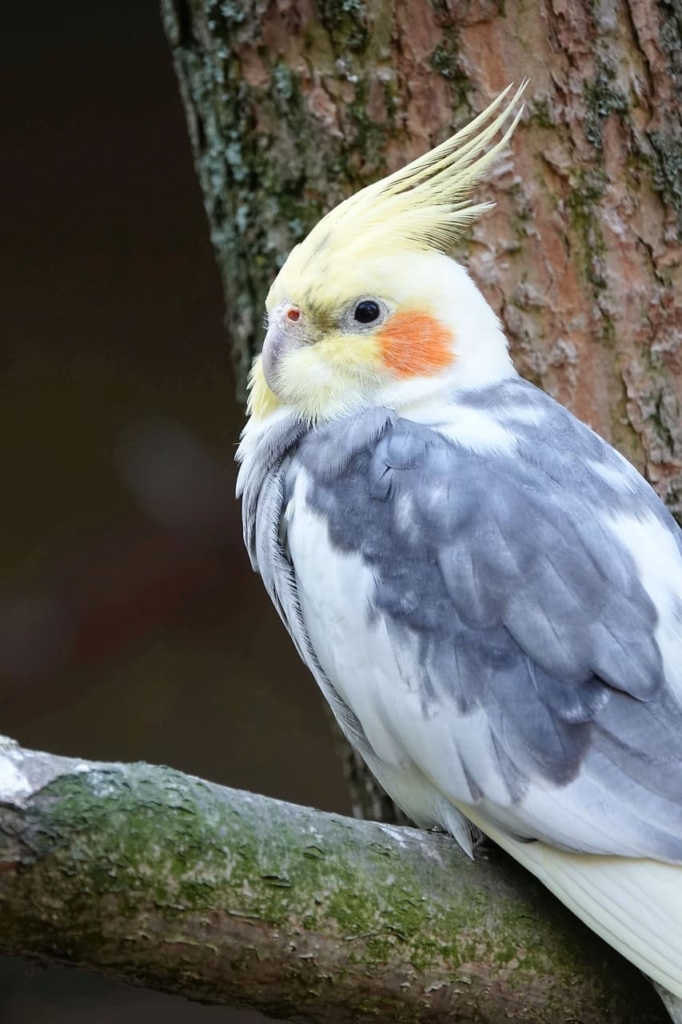
Caring for a bronzefallow cockatiel involves creating a comfortable and engaging environment. Regular interaction, mental stimulation, and a well-balanced diet are essential to their well-being. Incorporate a variety of toys and perches to keep them entertained.
As you welcome a bronzefallow cockatiel Bird into your home, you’ll find their radiant gleam and charming personality to be a source of endless joy.
Cockatiel Blood Feather
Cockatiel Bird blood feathers, also known as pin feathers, are a natural part of your bird’s growth and molting process. These feathers are actively growing and are connected to a blood supply, making them sensitive and susceptible to bleeding if damaged.
Should you notice a broken blood feather, it’s crucial to address it promptly. Gently plucking the damaged feather may be necessary to prevent excessive bleeding. Have styptic powder or cornstarch on hand to stop any bleeding that may occur. If you’re unsure or uncomfortable, consult an avian veterinarian for guidance.

Regularly inspect your cockatiel Bird’s feathers, especially during molting periods, to catch any issues early. By understanding and respecting the delicacy of blood feathers, you can ensure the safety and comfort of your beloved bird.
Butterfly Cockatiel
Butterfly cockatiel Birds are a delightful sight to behold, with their intricate patterns resembling the delicate wings of a butterfly. These enchanting variations of cockatiels add a touch of whimsy and elegance to the avian world.
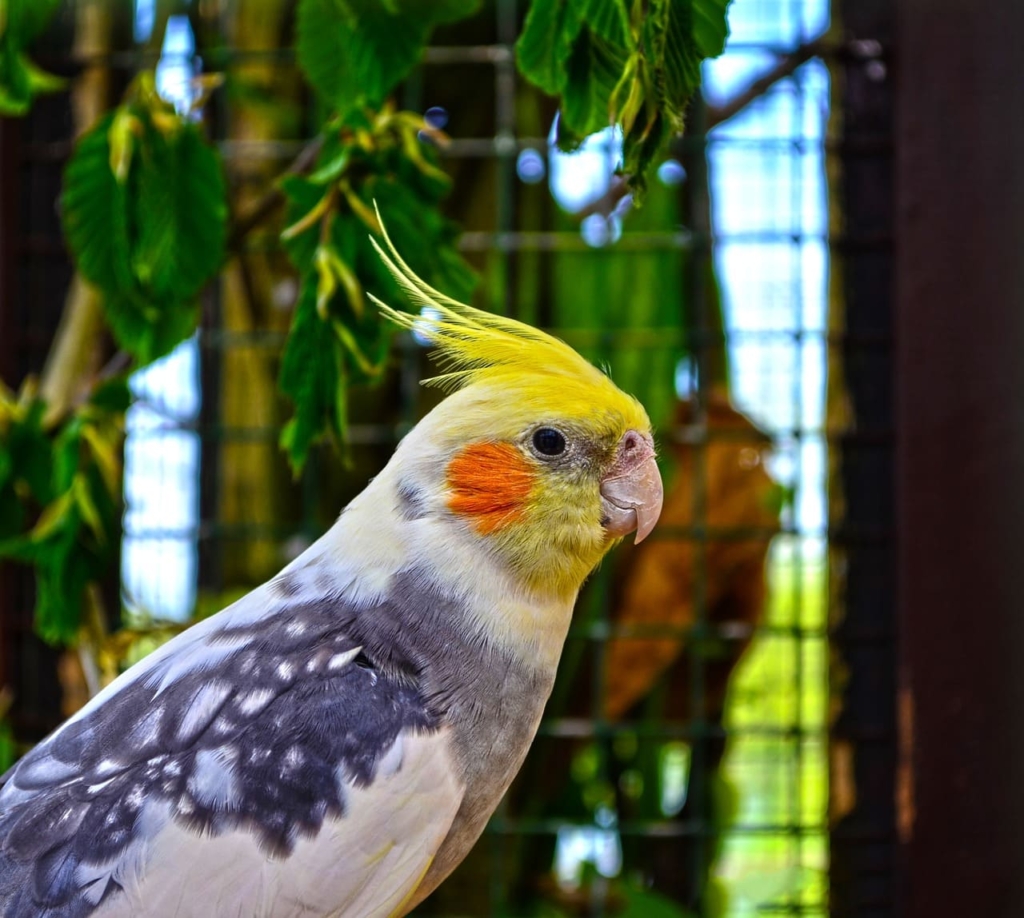
Caring for a butterfly cockatiel involves providing an environment that allows them to express their playful nature. Interactive toys, perches of varying textures, and a well-balanced diet are essential for their physical and mental well-being.
As they spread their wings and grace your home with their presence, butterfly cockatiel Birds remind us of the intricate beauty that exists in every corner of the natural world.
Pet Cockatiel
Pet cockatiel Birds are cherished members of countless households, bringing joy, entertainment, and a sense of companionship to their human families. These intelligent and social birds form strong bonds with their owners, creating a unique and fulfilling relationship.
Caring for a pet cockatiel involves providing an enriched environment. Interact with your bird through talking, whistling, and engaging playtime. A spacious cage equipped with toys, perches, and a balanced diet will contribute to their well-being.
The joy of having a pet cockatiel Bird goes beyond their stunning appearance; it’s about building a lasting connection that enriches both your life and theirs.
Cockatoo Vs Cockatiel
Comparison and differences between Cockatoo and Cockatiel Bird:
| Aspect | Cockatoo | Cockatiel Bird |
|---|---|---|
| Size | Generally larger with some species reaching 12-24 inches | Smaller, usually around 12 inches in length |
| Crest | Prominent crest on the head | Crest that can be raised, but less pronounced |
| Lifespan | Long lifespan, often 40-60 years | Lifespan of 15-20 years |
| Noise Level | Very vocal, can be loud and demanding | Vocal, but generally quieter than cockatoos |
| Personality | Intelligent, social, can be demanding | Playful, affectionate, and charming |
| Special Care | Requires extensive social interaction and mental stimulation | Requires social interaction and mental engagement |
| Feather Colors | Diverse range of colours and patterns | Various colour mutations and patterns |
Parakeet Vs Cockatiel
Comparison and differences between Parakeet and Cockatiel Bird:
| Aspect | Parakeet | Cockatiel Bird |
|---|---|---|
| Species Diversity | Encompasses various small parrot species | Specific species (Nymphicus hollandicus) |
| Size | Small, typically 7-18 inches in length | Small, usually around 12 inches in length |
| Crest | Some species have crests, but not all | Distinctive crest on the head |
| Lifespan | Varies by species, generally 5-15 years | Lifespan of 15-20 years |
| Noise Level | Can be vocal, but generally less loud than larger parrots | Vocal, with whistles and chirps |
| Personality | Social, playful, varies by species | Playful, affectionate, and charming |
| Feather Colors | Range of colours and patterns depending on species | Various colour mutations and patterns |
Male Vs Female Cockatiel
Comparison and differences between Male and Female Cockatiel:
| Aspect | Male Cockatiel | Female Cockatiel |
|---|---|---|
| Crest | Distinctive and often more raised crest | Crest that can be raised, but less pronounced |
| Behaviour | May be more vocal and prone to whistling | Generally quieter but still social |
| Plumage | Brighter and more vibrant colours | Generally similar to male in colouration |
| Personality | Can be more outgoing and attention-seeking | More reserved but still affectionate |
| Whistling Ability | More likely to learn and mimic tunes | May also learn tunes, but less common |
Cockatiel Vs Budgie
Comparison and differences between Cockatiel Bird and Budgie (Parakeet):
| Aspect | Cockatiel | Budgie (Parakeet) |
|---|---|---|
| Size | Small, usually around 12 inches in length | Small, typically 7-18 inches in length |
| Crest | Distinctive crest on the head | Some budgies have small crests |
| Lifespan | Lifespan of 15-20 years | Generally 5-10 years |
| Noise Level | Vocal with whistles and chirps | Chatter, may also mimic sounds and phrases |
| Personality | Playful, affectionate, and charming | Social, can be trained and tamed |
| Feather Colors | Various colour mutations and patterns | Range of colours, often with distinct patterns |

Cockatiel Vs Conure
Comparison and differences between Cockatiel Bird and Conure:
| Aspect | Cockatiel | Conure |
|---|---|---|
| Size | Small, usually around 12 inches in length | Small to medium-sized, varying by species |
| Crest | Distinctive crest on the head | Some species have crests or head markings |
| Lifespan | Lifespan of 15-20 years | Varies by species, generally 10-30 years |
| Noise Level | Vocal with whistles and chirps | Can be loud and vocal |
| Personality | Playful, affectionate, and charming | Energetic, playful, and social |
| Feather Colors | Various colour mutations and patterns | Range of colours and patterns |
15 Types Of Cockatiels
Some common types of cockatiel Birds based on their unique colour mutations and variations:
- Normal Gray Cockatiel: The wild-type colouration, featuring gray plumage with distinctive white wingbars, a yellow face, and a bright orange cheek patch.
- Lutino Cockatiel: Known for their striking yellow plumage, red eyes, and absence of gray markings. They’re a popular and vibrant variation.
- Cinnamon Cockatiel Bird: Characterized by their soft, warm cinnamon-brown feathers instead of the usual gray, resulting in a softer and earthier appearance.
- Pearl Cockatiel: Possessing unique “pearl” markings on their feathers, which appear as small dark spots or flecks on their wings and body.
- White-Faced Cockatiel: These cockatiels have a completely white or pale gray face, without the typical orange cheek patches. This gives them an elegant and unique appearance.
- Pied Cockatiel: Known for their patchy or “pied” pattern, featuring random blotches of colour on their body. Pied cockatiels can come in various colour combinations.
- Cinnamon Pearl Cockatiel: A charming combination of both cinnamon and pearl mutations, resulting in a bird with warm brown feathers and the distinctive pearl markings.
- Yellow-Cheeked Cockatiel Bird: These cockatiels have vibrant yellow cheek patches that contrast with their gray plumage, giving them a distinctive appearance.
- Silver Cockatiel: A variation with a slightly lighter gray hue and often featuring brighter orange cheek patches, creating an eye-catching contrast.
- Emerald Cockatiel: Rare and captivating, emerald cockatiel Birds showcase a vivid green tint in their plumage, adding a touch of exotic beauty.
- Albino Cockatiel: Completely devoid of pigment, albino cockatiels have pure white plumage, red eyes, and a distinct charm that comes from their lack of colour.
- Lacewing Cockatiel: Combining the traits of lutino and pearl mutations, lacewings have a mix of yellow and white feathers with the pearl pattern.
- Fallow Cockatiel: These birds have muted, pastel-like feathers due to a genetic mutation affecting their colouration, resulting in a soft and delicate appearance.
- Gloster Cockatiel Bird: A unique variation with a more pronounced crest that stands up almost vertically, giving them a distinctive appearance.
- Dark-Eyed Clear Cockatiel: An unusual variety with clear, white or pale yellow feathers and dark eyes, showcasing their unique genetic makeup.
Rare Cockatiel Colors
Rare cockatiel colours include the enchanting Emerald with its vivid green plumage, the unique Albino with its all-white feathers and red eyes, the delicate Fallow with muted pastel tones, and the striking Dark-Eyed Clear with its clear feathers and contrasting dark eyes, each showcasing the captivating diversity within the cockatiel Bird world.

Cockatiel Colors
Cockatiel colours offer a mesmerizing range, from vibrant to subtle hues, painting a diverse palette on these beloved companions. Each colour, whether striking like Black Cockatiel, elegant like Pearl Cockatiel, or vibrant like Green Cockatiel, brings unique charm. Explore the enchanting spectrum of avian diversity, from classic Grey and White to tropical Emerald Cockatiels.
White Cockatiel
The White Cockatiel Bird stands out with its pure and elegant plumage that radiates a timeless charm. Its all-white feathers create a striking contrast against its bright orange cheek patches, making for a captivating sight. This unique colour variation adds a touch of grace and simplicity to the already charming nature of cockatiels, offering a stunning addition to any avian enthusiast’s world.

Pearl Cockatiel
The Pearl Cockatiel boasts a distinctive and intricate pattern that sets it apart in the realm of avian companionship. Its feathers feature delicate markings, resembling pearls or intricate lace, scattered across its body. This enchanting variation adds an element of artistry to the cockatiel Bird’s appearance, offering a delightful blend of sophistication and charm.
Yellow Cockatiel
The Yellow Cockatiel Bird radiates warmth and cheer with its sunny and vibrant plumage. These birds showcase bright yellow feathers that light up their presence. With their friendly personalities and vivid colours, Yellow Cockatiels bring a ray of sunshine into the lives of those who welcome them as companions.

Blue Cockatiel
The Blue Cockatiel enchants with its captivating and soothing shades of blue. From soft pastels to deeper hues, these birds sport feathers that evoke a sense of tranquility and elegance. Their unique colouration adds a touch of serenity to the already charming nature of cockatiel Birds, creating a calming presence in any avian-loving home.
Grey Cockatiel
The Grey Cockatiel, with its classic and timeless colouration, captures hearts with its understated elegance. These birds exhibit soft, muted grey plumage that exudes a sense of refinement. Grey Cockatiel Birds’ simplicity and charm have made them beloved companions, showcasing that beauty lies in the subtlety of their feathers.

Black Cockatiel
The Black Cockatiel stands out as a captivating and striking variation among its peers. Its dark and mysterious plumage creates a stark contrast that draws attention. These birds offer a unique and bold presence, making them a rare gem for enthusiasts seeking something truly distinctive.
Green Cockatiel
The Green Cockatiel Bird adds a touch of tropical splendor with its vibrant and lively green plumage. This colour variation evokes images of lush foliage and exotic landscapes, bringing a refreshing and captivating aura to the world of cockatiel companionship.
Emerald Cockatiel
The Emerald Cockatiel Bird takes flight with its captivating and vivid green plumage that evokes images of lush forests. This rare and striking colour variation adds a touch of the exotic to the cockatiel family, enchanting avian enthusiasts with its vibrant beauty.
Silver Cockatiel
The Silver Cockatiel shines with its distinctive hue that falls between the classic grey and white colourations. Their feathers feature a soft and lustrous silver tint, creating an ethereal and elegant appearance. This unique variation adds a touch of sophistication and charm to the world of cockatiel companionship.
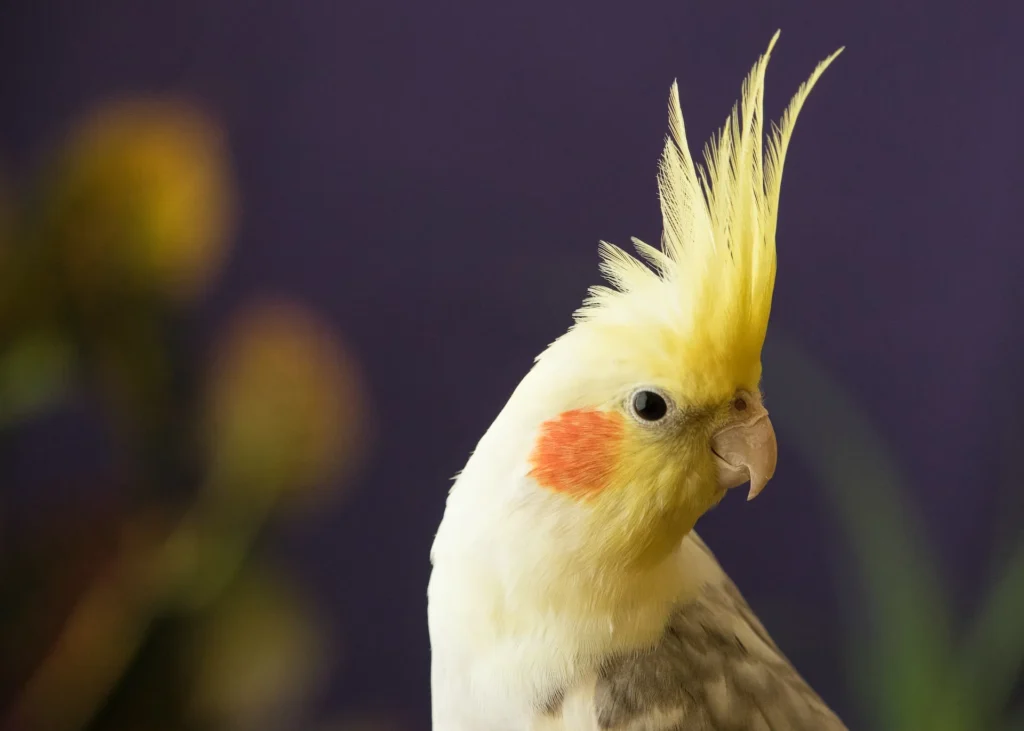
Cockatiel Mutations
Cockatiel mutations are a captivating aspect of these birds’ genetic diversity. These mutations result in unique colour variations, ranging from strikingly vivid to subtle and elegant. From the radiant hues of Lutino and Albino cockatiel Birds to the intricate patterns of Pearl and Pied cockatiels, each mutation adds a layer of charm to these beloved companions, making them even more alluring to avian enthusiasts.
History of Cockatiel Bird
The history of the Cockatiel bird traces back to the vast landscapes of Australia. While these charming birds are now cherished as beloved companions worldwide, they were first discovered in their native habitats. From their wild beginnings to their journey into domestication, the Cockatiel Bird’s history is a testament to the enduring bond between humans and animals.
Appearance of Cockatiel Bird
The Cockatiel Bird’s appearance is a harmonious blend of grace and charm. With their distinct crest, bright eyes, and captivating colour variations, these birds are a feast for the eyes. Their elegantly curved beaks and expressive features reflect their personalities, creating an avian companion that’s not only delightful to the heart but also a pleasure to behold.

Temperament of Cockatiel Bird
The Cockatiel Bird’s temperament is a harmonious blend of playfulness and affection. Known for their friendly and gentle nature, these birds are quick to form bonds with their human companions. Their curious demeanour, playful antics, and melodious songs add a touch of joy and liveliness to any household, making them cherished members of the family.
Cockatiel Mating Behavior
Cockatiel mating behaviour offers a glimpse into the intricate world of avian relationships. These birds engage in courtship rituals that involve preening, vocalizations, and displays of affection. Understanding their natural behaviours during mating season can help bird enthusiasts provide a supportive and comfortable environment that respects their instincts.
Cockatiel Body Language
Cockatiel Bird body language speaks volumes about their emotions and needs. From crest position and wing movement to beak gestures, these subtle cues reveal whether they’re content, curious, or in need of attention. Learning to interpret their body language fosters a deeper understanding of your feathered friend, enhancing the bond you share.
Can Cockatiels Talk
While not as renowned for their talking abilities as some other parrot species, Cockatiel Birds can indeed learn to mimic sounds and words. Their melodic whistles and occasional words can bring a charming and personal touch to their interactions with humans, adding an element of surprise and entertainment to their already endearing personalities.

What Do Cockatiels Eat
Cockatiels thrive on a balanced diet that includes a mix of high-quality pellets, seeds, fresh fruits, and vegetables. Their nutritional needs encompass a variety of nutrients essential for their well-being, such as vitamins, minerals, and proteins.
Are Cockatiels Good Pets
Cockatiels are renowned for their gentle and affectionate nature, making them excellent companions for bird enthusiasts of all levels. Their playful interactions, ability to form strong bonds, and willingness to engage with their human caregivers contribute to their reputation as wonderful and rewarding pets.
Are Cockatiels Loud
Cockatiel Birds are generally considered quieter than larger parrot species, making them more suitable for apartment living or shared spaces. While they do vocalize with whistles, chirps, and occasional squawks, their noise level is often more manageable, adding an enjoyable background of avian melodies to your home.
Where Are Cockatiels From
Cockatiel Birds originate from the vast landscapes of Australia, particularly in regions such as the outback and forests. Their native habitat has influenced their behaviours, colour variations, and unique characteristics.

Where To Buy A Cockatiel
Cockatiels can be purchased from reputable pet stores, bird breeders, or adoption centers. Choosing a source that prioritizes the birds’ well-being and health is essential. Researching and visiting potential sources allows you to find a cockatiel that’s a perfect fit for your home and lifestyle.
How To Tame A Cockatiel
Taming a Cockatiel Bird requires patience, consistency, and gentle interactions. Gradually building trust through offering treats, spending time near the bird, and using a calm tone helps them feel secure. Slowly introducing hands for perching and stepping up encourages a positive relationship built on mutual understanding.
Anatomy Of Cockatiel
The anatomy of a Cockatiel Bird is a fascinating blend of features designed for survival and interaction. Their crest, eyes, beak, feet, and plumage each serve a specific purpose, contributing to their ability to navigate their environment, communicate, and express emotions.
Cockatiel In Spanish

The term “Cockatiel” in Spanish is “Cacatúa de Moño Amarillo.” Just like in English, these birds are cherished for their endearing personalities and charming presence. Their name in Spanish captures their unique features and holds a special place in the world of avian companionship.
Cockatiel Molting
Cockatiel Bird molting is a natural process where birds shed old feathers to make way for new ones. During this time, you may notice increased feather loss and changes in your bird’s appearance. Providing a nutritious diet, maintaining a stress-free environment, and offering opportunities for preening can support them through this natural renewal process.
Cockatiel Price
Cockatiel Bird prices can vary across countries. In the United States, they range from approximately $80 to $250, while in India, prices are around ₹1,500 to ₹5,000. Factors such as age, colour mutation, and breeder reputation influence these prices.
Cockatiel Price in the United States
In the United States, the price of a Cockatiel can range from $80 to $250, depending on factors like the bird’s age, colour mutation. Some specialty colour mutations or hand-fed babies might be priced at the higher end of the spectrum.
Cockatiel Price in the United Kingdom
In the United Kingdom, Cockatiel prices typically range from £60 to £150 or more. As with other countries, the price can vary based on factors like the bird’s age, colour mutation, and whether it’s hand-reared or not.
Cockatiel Price in Australia
In Australia, where Cockatiels are native, prices can range from $50 to $150 AUD or more. The availability of these birds may affect the price, as they are more commonly found in the wild.
Cockatiel Price in Canada
In Canada, Cockatiel prices typically range from $100 to $300 CAD. Similar to other countries, the price can vary based on factors such as the bird’s age, colour mutation, and breeder reputation.
Cockatiel Bird Price In India
In India, Cockatiel prices can range from around ₹1,500 to ₹5,000 or more. Prices may vary based on factors such as the bird’s age, colour mutation, and whether it’s hand-tamed.
Cockatiel Bird Price In Bangalore
In Bangalore, India, the price of a Cockatiel bird can range from ₹1,500 to ₹3,500 or more, depending on factors such as colour mutation, age, and breeder reputation.
Cockatiel Bird Price In Chennai
In Chennai, India, the price of a Cockatiel bird can vary between ₹1,800 and ₹4,000 or more, influenced by factors like colour mutation, age, and availability.
Cockatiel Bird Price In Kolkata
In Kolkata, India, the price of a Cockatiel bird typically falls within the range of ₹1,500 to ₹3,800 or more, with variations based on colour mutation and breeder credibility.
Cockatiel Bird Price In Coimbatore
In Coimbatore, India, the price of a Cockatiel bird can range from ₹1,500 to ₹3,500 or more, depending on factors like colour mutation, age, and the reputation of the breeder.
Cockatiel Bird Price In Pune
In Pune, India, the price of a Cockatiel bird generally falls between ₹1,500 and ₹4,000 or more. This price range can be influenced by factors such as colour mutation, age, and source.
Cockatiel Bird Price In Delhi
In Delhi, India, the price of a Cockatiel bird can vary from ₹1,500 to ₹4,500 or more, depending on factors such as colour mutation, age, and breeder reputation.
Cockatiel Bird Price In Hyderabad
In Hyderabad, India, the price of a Cockatiel bird typically ranges from ₹1,500 to ₹3,800 or more. Prices can vary based on factors like colour mutation and breeder credibility.
Cockatiel Bird Price In Madurai
In Madurai, India, the price of a Cockatiel bird can vary between ₹1,500 and ₹3,500 or more, influenced by factors such as colour mutation, age, and the reputation of the breeder.
Cockatiel Bird Price In Mumbai
In Mumbai, India, the price of a Cockatiel bird can range from ₹1,800 to ₹4,500 or more, with variations based on colour mutation, age, and the credibility of the breeder.
Cockatiel Bird Price In Tamil Nadu
In Tamil Nadu, India, the price of a Cockatiel bird typically falls within the range of ₹1,500 to ₹4,000 or more, with variations based on colour mutation, age, and breeder reputation.
Lutino Cockatiel Price
The price of a Lutino Cockatiel, known for its vibrant yellow plumage and red eyes, can range from approximately $100 to $300 USD or more, depending on location, availability, and breeder reputation.
White Cockatiel Bird Price
The price of a White Cockatiel bird, celebrated for its elegant all-white plumage, can vary from around $80 to $250 USD or more, depending on factors such as location, availability, and breeder reputation.
White Cockatiel Bird Price In India
In India, the price of a White Cockatiel bird can range from ₹1,500 to ₹4,000 or more, influenced by factors like location, availability, and breeder reputation.
Albino Cockatiel Price
The price of an Albino Cockatiel, featuring white feathers and red eyes, can range from approximately $100 to $300 USD or more, depending on location, availability, and breeder reputation.
Cockatiel Bird Prices In Major Indian and USA Cities
Average Cockatiel Bird Prices In Major Indian and USA Cities:
| City | Cockatiel Bird Price |
|---|---|
| Cockatiel Bird Price In Mumbai | ₹1,800 – ₹4,500 |
| Cockatiel Bird Price In Delhi | ₹1,500 – ₹4,500 |
| Cockatiel Bird Price In Bangalore | ₹1,500 – ₹3,500 |
| Cockatiel Bird Price In Chennai | ₹1,800 – ₹4,000 |
| Cockatiel Bird Price In Hyderabad | ₹1,500 – ₹3,800 |
| Cockatiel Bird Price In Kolkata | ₹1,500 – ₹3,800 |
| Cockatiel Bird Price In Pune | ₹1,500 – ₹4,000 |
| Cockatiel Bird Price In Ahmedabad | ₹1,500 – ₹3,500 |
| Cockatiel Bird Price In New York | $80 – $300 |
| Cockatiel Bird Price In Los Angeles | $80 – $300 |
| Cockatiel Bird Price In Chicago | $80 – $300 |
| Cockatiel Bird Price In Houston | $80 – $300 |
| Cockatiel Bird Price In Phoenix | $80 – $300 |
| Cockatiel Bird Price In Philadelphia | $80 – $300 |
| Cockatiel Bird Price In Bengaluru | ₹1,500 – ₹3,500 |
| Cockatiel Bird Price In San Francisco | $80 – $300 |
| Cockatiel Bird Price In Chennai | ₹1,800 – ₹4,000 |
| Cockatiel Bird Price In Dallas | $80 – $300 |
| Cockatiel Bird Price In Kolkata | ₹1,500 – ₹3,800 |
| Cockatiel Bird Price In Washington | $80 – $300 |
| Cockatiel Bird Price In Hyderabad | ₹1,500 – ₹3,800 |
| Cockatiel Bird Price In Mumbai | ₹1,800 – ₹4,500 |
| Cockatiel Bird Price In Pune | ₹1,500 – ₹4,000 |
| Cockatiel Bird Price In Chennai | ₹1,800 – ₹4,000 |
Cockatiel Breeder
Top Cockatiel Bird Breeders in different countries:
| Country | City | Breeder Name |
|---|---|---|
| United States | Los Angeles | Feathered Friends Aviary |
| United Kingdom | London | Avian Haven |
| Australia | Sydney | Outback Wings |
| Canada | Toronto | Maple Aviaries |
| India | Mumbai | Tropic Wings Aviary |
| Germany | Berlin | Vogelparadies |
| France | Paris | Plumes Exotiques |
| Japan | Tokyo | Sakura Aviaries |
| Brazil | São Paulo | Aviário Tropical |
| South Africa | Johannesburg | Feathered Haven |
Factors that Affect the Price of Cockatiel Birds
Factors affecting Cockatiel prices include:
- Colour Mutation: Unique colours like Lutino or Albino can raise prices due to rarity and demand.
- Age: Baby Cockatiels cost more due to intensive care needs.
- Health & Genetics: Healthy birds with good genetics fetch higher prices.
- Breeder Reputation: Reputable breeders charge more for quality care.
- Training & Socialization: Well-trained, friendly birds command higher prices.

Monthly Maintenance Cost of Cockatiel Bird:
Caring for a Cockatiel Bird involves ongoing costs to ensure the bird’s well-being. Monthly maintenance expenses can include:
- Food: A varied and balanced diet consisting of high-quality pellets, fresh fruits, vegetables, and occasional treats is essential for a Cockatiel Bird’s health.
- Cage and Supplies: The cage, perches, toys, and accessories need to be kept clean and in good condition for the bird’s comfort and enrichment.
- Veterinary Care: Regular check-ups and potential medical expenses should be budgeted for the bird’s health and well-being.
- Bedding: Lining the cage with suitable bedding material for cleanliness and comfort.
- Toys and Enrichment: Providing toys and activities to prevent boredom and stimulate the bird’s mental and physical activity.
- Grooming: Nail trims and occasional feather trims may be necessary.
- Heating or Cooling: Ensuring the bird is comfortable in its environment, especially during extreme weather conditions.
- Miscellaneous Costs: This includes items like cleaning supplies, travel carriers, and any unexpected expenses that may arise.
Cockatiel Facts
Certainly, here are some interesting Cockatiel facts:
- Native to Australia: Cockatiel Birds (Nymphicus hollandicus) are native to the arid regions of Australia, particularly in the Outback.
- Social Creatures: Cockatiels are highly social birds known for their friendly and affectionate nature. They often form strong bonds with their human caregivers.
- Crest Display: The distinctive crest atop a Cockatiel’s head can be raised or lowered, indicating their mood or level of excitement.
- Vocal Abilities: While not as accomplished as larger parrot species, Cockatiels are capable of whistling, chirping, and mimicking certain sounds and phrases.
- Variety of Colors: Cockatiel Birds come in various colour mutations, including Lutino, Albino, Pearl, and Cinnamon, each showcasing unique and captivating appearances.
- Wild Diet: In their natural habitat, Cockatiels primarily feed on seeds, grasses, and plant materials.
- Playful Personalities: These birds are known for their playful antics, which include head-bobbing, wing-flapping, and even dancing.
- Life Span: With proper care, Cockatiel Birds can live anywhere from 15 to 25 years or more, making them long-term companions.
- Nesting Behavior: Cockatiel Birds exhibit nesting behaviours even in captivity, such as exploring potential nesting spots and creating nests from available materials.
- Molting: Molting is a natural process where Cockatiels shed old feathers and replace them with new ones. This can impact their appearance and behaviour.

Cockatiels As Pets Pros And Cons
Here are some common pros and cons of keeping Cockatiel Birds as pets:
| Pros of Keeping Cockatiels as Pets | Cons of Keeping Cockatiels as Pets |
|---|---|
| Friendly and Affectionate: Cockatiels are known for forming strong bonds with their owners and often enjoy cuddling and interacting. | Noise Level: While quieter than some parrot species, Cockatiel Birds can still produce loud chirps, whistles, and calls, which might not be suitable for noise-sensitive environments. |
| Playful Personalities: Cockatiel Birds are playful and enjoy various toys and activities, making them entertaining companions. | Messy Eaters: Cockatiels can be messy eaters, scattering seeds and debris around their cage, requiring regular cleaning. |
| Mimicking Abilities: While not as advanced as larger parrot species, Cockatiels can learn to mimic sounds, whistles, and even simple phrases. | Lifespan: Their long lifespan requires a long-term commitment, ensuring they receive proper care and attention for up to 25 years or more. |
Cockatiel Care
Proper Cockatiel Bird care is crucial for their health and well-being. Follow these guidelines:
- Diet: Offer a balanced diet of pellets, fresh fruits, vegetables, and occasional treats. Ensure clean, fresh water is always available.
- Cage Setup: Provide a spacious cage with various perches and toys for mental stimulation. Keep the cage clean and change cage liners regularly.
- Social Interaction: Spend time with your Cockatiel Bird daily to prevent loneliness and boredom. They enjoy companionship and thrive with interaction.
- Grooming: Trim nails and provide opportunities for natural beak maintenance. Offer cuttlebone and mineral blocks for beak health.
- Healthcare: Schedule regular vet check-ups to monitor health and catch potential issues early. Look for signs of illness, changes in behaviour, or appearance.
- Enrichment: Rotate toys regularly to prevent boredom. Offer toys that encourage climbing, foraging, and mental engagement.
- Sunlight: Provide access to natural sunlight or full-spectrum lighting to support their overall health.
- Quiet and Rest: Offer a quiet, dark environment for 10-12 hours of uninterrupted sleep each night.

Cockatiel Training
Training your Cockatiel Bird can be a rewarding experience. Follow these steps:
- Start Slowly: Begin with simple commands like “step up.” Use positive reinforcement, like treats or praise, to reward desired behaviours.
- Be Consistent: Consistency is key. Use the same cues for each command and reward immediately after the desired behaviour.
- Short Sessions: Keep training sessions short, about 10-15 minutes, to maintain your Cockatiel Bird’s interest and prevent frustration.
- Use Treats: Utilize their favourite treats as rewards to encourage them to follow commands.
- Positive Environment: Train in a quiet, calm space to minimize distractions and anxiety.
- Gradual Progress: As your Cockatiel Bird becomes more comfortable, gradually introduce new commands and behaviours.
- Patience: Every bird learns at their own pace. Be patient and understanding of their progress.
- Social Interaction: Training sessions also strengthen the bond between you and your Cockatiel.
Cockatiel Beak
The Cockatiel’s beak serves multiple functions beyond eating. It helps them climb, explore, and preen their feathers. Providing wooden toys and mineral blocks helps maintain the health of their beak by preventing overgrowth.

Cockatiel Beak Grinding
Cockatiel Bird beak grinding is a sign of contentment and relaxation. This rhythmic sound indicates they’re comfortable and at ease, often occurring during restful moments or when they’re ready to sleep.
Cockatiel Flying
Allowing Cockatiel Birds to fly in a safe and supervised environment is essential for their physical and mental health. Regular flight helps maintain muscle strength and encourages natural behaviours.
Cockatiel Screaming
Cockatiel screaming can be a way of seeking attention, expressing excitement, or indicating distress. Addressing the underlying cause and providing mental stimulation can help reduce excessive screaming.

Cockatiel Sneezing
Occasional sneezing is normal for Cockatiel Birds as a way to clear their respiratory passages. However, persistent or accompanied by other symptoms might indicate a health issue and should be evaluated by a vet.
Cockatiel Temperature
Maintaining the right temperature range (70-80°F) is crucial for Cockatiels’ health. Avoid exposing them to drafts or extreme heat, as it can lead to stress and health problems.
Cockatiel Diet
A well-rounded Cockatiel diet includes high-quality pellets, fresh vegetables, fruits, and occasional treats. Avoid avocados, chocolate, caffeine, and high-fat foods. Fresh water should always be available.

Cockatiel Plush
Cockatiel plush toys can provide comfort and entertainment. However, ensure they are bird-safe and free from small parts that could be ingested.
Cockatiel Sleeping
Cockatiels need 10-12 hours of sleep per night. Covering their cage and ensuring a quiet, dark environment helps them get restful sleep.
Cockatiel Cage Setup
Cockatiel Cage Setup:
- Choose the Right Cage: Select a spacious cage with horizontal bars and appropriate bar spacing to prevent escapes.
- Perches Variety: Offer perches of different sizes and textures to exercise their feet and prevent foot problems.
- Enrichment Toys: Include toys for mental stimulation, such as foraging toys, chew toys, and climbing structures.
- Feeding Area: Set up a designated spot for food and water dishes, away from perches to avoid contamination.
- Balanced Diet: Provide fresh water and a balanced diet of pellets, fresh fruits, vegetables, and occasional treats.
- Optional Nesting Box: If breeding, add a suitable nesting box in a corner for privacy.
- Cage Liners: Use newspaper or cage liners for easy cleanup of droppings.
- Safe Accessories: Avoid mirrors and choose bird-safe toys and accessories without small parts.
- Social Interaction: Position the cage where your Cockatiel can interact with family members.
- Regular Cleaning: Keep the cage, perches, toys, and dishes clean to prevent bacterial buildup.
Size Of A Cockatiel
Cockatiel Birds are small to medium-sized birds, typically measuring around 12-14 inches in length, including their tail.
Cockatiel Cage Size
An ideal Cockatiel cage size should be at least 20 inches in length, width, and height to allow them to move comfortably and spread their wings.
Cockatiel Whistling
Cockatiel Birds are known for their whistling abilities. They can mimic tunes, learn household sounds, and even create their unique melodies.
Cockatiels Singing
Cockatiel Birds have a melodious song that varies between individuals. Males are more likely to sing and whistle, while females produce softer vocalizations.
Cockatiel Breeding
Breeding Cockatiel Birds requires careful planning and understanding of their behaviours. Provide a suitable nesting box and monitor their health and behaviour during the breeding process.
Cockatiel Eggs
Cockatiel Bird eggs are usually laid in clutches of 4-6 eggs. Ensure a comfortable nesting environment and proper nutrition during this period.
Fertile Cockatiel Eggs
Fertile Cockatiel eggs are viable for hatching if they have been fertilized by a male. Breeding conditions and proper incubation are essential for successful hatching.
Cockatiel Nesting
Cockatiels may exhibit nesting behaviours, even in captivity. Provide nesting materials and monitor their behaviour closely during this period.
Cockatiel Pronunciation
The pronunciation of “Cockatiel” is usually “kaw-kuh-teel,” with the emphasis on the second syllable.
8 Week Old Cockatiel
An 8-week-old Cockatiel Bird is considered a juvenile. At this age, they are transitioning from being dependent on their parents to becoming more independent. Juvenile Cockatiels are still developing both physically and mentally. It’s a critical phase for their socialization and training. They may start exploring their environment more and are often curious and eager to learn.
Health Issues of Cockatiel Bird
Cockatiel Birds can face various health issues, including respiratory infections, obesity, feather plucking, and beak overgrowth. Regular veterinary check-ups are essential to catch any health problems early. Providing a balanced diet, maintaining proper hygiene in their cage, and ensuring a stress-free environment can help prevent many health issues. Being observant of changes in behaviour, appetite, and physical appearance can aid in identifying potential health concerns.

Sick Cockatiel
A sick Cockatiel Bird may display symptoms like lethargy, fluffed feathers, changes in appetite, sneezing, wheezing, discharge from the eyes or beak, and a change in droppings. If you suspect your Cockatiel is unwell, seek veterinary attention promptly. Sick Cockatiels can deteriorate rapidly, so early intervention is crucial for their recovery.
Cockatiel Lifespan
With proper care and a suitable environment, Cockatiel Birds can live anywhere from 15 to 25 years or even longer. Factors affecting their lifespan include genetics, diet, exercise, veterinary care, and overall well-being.
Cockatiel Food
Best food for Cockatiel Birds:
| Food Type | Description |
|---|---|
| Pellets | Nutritionally balanced pellets provide essential vitamins and minerals. Choose high-quality brands. |
| Fresh Fruits | Offer a variety of fresh fruits like apples, grapes, and berries for added vitamins and hydration. |
| Vegetables | Include veggies such as carrots, bell peppers, and leafy greens for dietary diversity. |
| Seeds and Grains | Use seeds as treats due to their high-fat content. Provide millet sprays or seed mixes in moderation. |
| Protein Sources | Cooked eggs, lean cooked meat, or small amounts of cheese can be given occasionally. |
| Cuttlebone and Grit | Provide cuttlebone for calcium and grit for digestion, but don’t overdo it. |
| Treats | Offer treats like whole-grain bread, small pieces of nuts, or dried fruits in moderation. |
| Water | Fresh, clean water should always be available for your Cockatiel. |
Cockatiel Names
Popular Names for Cockatiel Birds:
| Gender-Neutral Names | Male Names | Female Names |
|---|---|---|
| Sunny | Charlie | Daisy |
| Peanut | Oliver | Bella |
| Sky | Max | Luna |
| Rio | Rocky | Rosie |
| Kiwi | Jasper | Ruby |
| Mochi | Leo | Lily |
| Mango | Toby | Chloe |
| Sprite | Benny | Willow |
Best Toys For Cockatiels
Best Toys for Cockatiel Birds:
| Toy Type | Description |
|---|---|
| Foraging Toys | Toys that encourage searching for hidden treats. |
| Climbing Structures | Ladders, ropes, and platforms for exercise. |
| Shreddable Toys | Toys made of natural materials for chewing and shredding. |
| Mirrors | Mirrors can provide entertainment and stimulation. |
| Puzzle Toys | Toys that challenge your Cockatiel’s problem-solving skills. |
| Bells and Chimes | Toys with bells or chimes for auditory stimulation. |
| Swings | Swings provide both mental and physical stimulation. |
| Interactive Toys | Toys with moving parts that engage your Cockatiel. |
Cockatiel Videos
Conclusion:
In conclusion, caring for a Cockatiel Bird involves providing a balanced diet, a comfortable living environment, social interaction, and regular veterinary care. Training can strengthen the bond between you and your bird, enhancing their mental stimulation. Choosing suitable names adds a personal touch to your companion. Offering a variety of engaging toys ensures both physical and mental enrichment. By focusing on these aspects, you can provide a fulfilling and joyful life for your Cockatiel Bird.
Frequently Asked Questions on Cockatiel Birds:
How Long Do Cockatiels Live
Cockatiels, on average, have a lifespan of about 15 to 20 years in captivity. With proper care, a healthy diet, and a suitable environment, some cockatiel Birds have been known to live even longer, occasionally reaching their late 20s.
How Much Are Cockatiels
The cost of cockatiels can vary widely depending on factors such as the bird’s age, colour mutation, and where you purchase it. On average, you can expect to pay anywhere from $80 to $250 for a pet cockatiel.
Can Cockatiels Talk
Yes, cockatiels are known for their ability to mimic sounds and even learn a few words and phrases. While they are not as adept at talking as some other parrot species, many cockatiels can learn to mimic whistles, tunes, and simple phrases with patience and consistent training.
Are Cockatiels Loud
Cockatiel Birds are generally not as loud as larger parrot species, but they can still produce various sounds such as whistles, chirps, and occasional squawks. Their vocalizations are a form of communication, and while they might not be overwhelmingly loud, they can still be audible, especially during certain times of the day or when seeking attention.
Where Are Cockatiels From
Cockatiel Birds (Nymphicus hollandicus) are native to Australia. They are found across various regions of the country, primarily in arid or semi-arid areas. In the wild, they inhabit scrublands, woodlands, and coastal regions.
Where To Buy A Cockatiel
Cockatiels can be purchased from pet stores, avian breeders, bird expos, and adoption centers. It’s recommended to buy from reputable sources that prioritize the well-being of their birds and provide proper care information.
Are Cockatiels Good Pets
Yes, cockatiels can make wonderful pets for the right individuals or families. They are known for their charming personalities, relatively small size, and ability to form strong bonds with their human caregivers.

What Do Cockatiels Eat
Cockatiels should be fed a balanced diet that includes high-quality pellet food formulated for cockatiels, fresh vegetables, fruits, and occasional treats. Providing a variety of foods ensures they receive essential nutrients for optimal health.
Can Cockatiels Eat Bananas
Yes, cockatiel Birds can eat bananas in moderation. Bananas are a good source of vitamins and minerals, but they are also high in sugar. Offer small pieces as an occasional treat rather than a regular part of their diet.
Can Cockatiels Eat Grapes
Yes, cockatiels can eat grapes, but they should be seedless and cut into small pieces to prevent choking. Grapes can be a tasty and nutritious treat when given in moderation.
Can Cockatiels Eat Strawberries
Yes, strawberries can be given to cockatiels as an occasional treat. Make sure to wash them thoroughly, remove any leaves or stems, and cut them into small, manageable pieces.
Can Cockatiels Eat Watermelon
Yes, cockatiel Birds can enjoy watermelon as an occasional treat. Remove the seeds and offer only the flesh of the fruit in small, bite-sized portions.
Can Cockatiels Eat Apples
Yes, cockatiel Birds can eat apples. Apples are a good source of vitamins and fiber. Remove the seeds and core, and offer small pieces with the skin on.
Can Cockatiels Eat Blueberries
Yes, blueberries can be given to cockatiels as a treat. Blueberries are rich in antioxidants and can be a healthy addition to their diet when offered in moderation.
Can Cockatiels Eat Cucumber
Yes, cockatiels can eat cucumber. Cucumber is hydrating and low in calories, making it a refreshing snack for them.
Can Cockatiels Eat Oranges
Cockatiel Birds can eat oranges, but they should be given in small amounts due to their high acidity. Remove any seeds and offer only the flesh as an occasional treat.
Can Cockatiels Eat Carrots
Yes, cockatiels can eat carrots. Carrots are a good source of vitamins and can be offered in small, grated portions or thin slices.
Can Cockatiels Eat Tomatoes
Tomatoes are not recommended for cockatiel Birds, as they can be acidic and may cause digestive issues. It’s best to avoid offering tomatoes to your bird.
Can Cockatiels Eat Bread
While cockatiel Birds may nibble on small amounts of bread, it is not a suitable food for them. Bread lacks the necessary nutrients and can fill them up without providing the essential vitamins and minerals they need.
Can Cockatiels Eat Celery
Yes, cockatiels can eat celery in small amounts. Celery is low in calories and can provide some variety in their diet.
Can Cockatiels Eat Cheese
Cheese is not recommended for cockatiel Birds. They are lactose intolerant and may have trouble digesting dairy products.
Can Cockatiels Eat Lettuce
Lettuce doesn’t offer significant nutritional value and can sometimes cause digestive issues. It’s better to offer leafy greens with higher nutritional content, such as kale or spinach, in moderation.
Can Cockatiels Eat Peanuts
Peanuts should be avoided in a cockatiel Bird’s diet, as they can harbor a type of mold that is toxic to birds. Additionally, peanuts are high in fat and can lead to obesity and health problems.
Can Cockatiels Eat Pineapple
Yes, cockatiels can eat pineapple in small amounts. Pineapple is rich in vitamins and enzymes, but its high sugar content means it should be given as an occasional treat.
Can Cockatiels Eat Broccoli
Yes, cockatiel Birds can eat broccoli. Broccoli is a nutritious vegetable that can be offered in small, bite-sized pieces.
Can Cockatiels Eat Eggs
Cooked eggs can be a good source of protein for cockatiels. Offer small amounts of scrambled or boiled egg as an occasional treat.
Can Cockatiels Eat Mango
Yes, cockatiels can eat mango. Mango is rich in vitamins and can be offered as a treat, but be sure to remove the pit and offer only the flesh.
Can Cockatiels Eat Parakeet Food
Cockatiel Birds have specific dietary requirements, and while some elements of parakeet food might be suitable, it’s best to feed them a diet formulated specifically for cockatiels to ensure they receive the necessary nutrients.
Can Cockatiels Eat Peanut Butter
Peanut butter is not recommended for cockatiels. It’s high in fat and may contain additives that aren’t suitable for their diet.
Can Cockatiels Eat Pistachios
Pistachios should be avoided in a cockatiel’s diet due to their high fat content. They can lead to health issues if consumed regularly.
Can Cockatiels Eat Popcorn
Plain, air-popped popcorn can be given to cockatiel Birds as an occasional snack, but make sure it’s unsalted and free of any butter or flavourings.
Can Cockatiels Eat Almonds
Almonds should be given sparingly to cockatiels due to their high fat content. Too many almonds can contribute to obesity.
Can Cockatiels Eat Blackberries
Yes, blackberries can be offered to cockatiels as a treat. They contain antioxidants and can provide some variety in their diet.
Can Cockatiels Eat Cilantro
Cilantro can be given to cockatiel Birds in small amounts as part of a varied diet. Make sure to wash it thoroughly before offering.
Can Cockatiels Eat Raspberries
Yes, cockatiels can eat raspberries as a treat. Raspberries are rich in vitamins and antioxidants.
Can Cockatiels Eat Rice
Cooked plain rice can be given to cockatiel Birds in small amounts as an occasional treat. Avoid adding any seasonings or additives.
Can Cockatiels Eat Spinach
Yes, cockatiels can eat spinach in moderation. Spinach is a nutrient-rich leafy green that can be a valuable addition to their diet.
Can Cockatiels Eat Cantaloupe
Yes, cockatiel Birds can eat cantaloupe as an occasional treat. Remove the seeds and offer only the flesh.
Can Cockatiels Eat Peaches
Yes, cockatiels can eat peaches. Peaches should be pitted and cut into small, manageable pieces before being offered.
Can Cockatiels Eat Pomegranate
Yes, cockaties Birds can eat pomegranate seeds as a treat. Pomegranate is rich in antioxidants and can provide some variety in their diet.
Can Cockatiels Eat Cabbage
Cabbage can be given to cockatiels in small amounts, but it should be offered infrequently due to its potential to cause gas.
Can Cockatiels Eat Cherries
Cherries can be offered to cockatiels as an occasional treat. Make sure to remove the pit and offer only the flesh.
Can Cockatiels Eat Chicken
Cooked, boneless, and plain chicken can be offered to cockatiels in very small amounts as a protein source, but it should not be a regular part of their diet.
Can Cockatiels Eat Pumpkin Seeds
Pumpkin seeds can be given to cockatiels as an occasional treat. They are a good source of healthy fats and nutrients.
Can Cockatiels Eat Walnuts
Walnuts can be offered to cockatiel Birds in small amounts, but their high fat content means they should be given sparingly.
Do Cockatiels Eat Bugs
In the wild, cockatiels might consume insects and bugs as part of their natural diet. However, in captivity, they do not typically require insects as a primary food source.
What Can Cockatiels Eat List
Cockatiels can eat a variety of foods, including high-quality pellet food formulated for cockatiels, fresh vegetables (carrots, broccoli, spinach, etc.), fruits (apple, banana, berry varieties), and occasional treats like whole grains (cooked rice, plain popcorn). Avoid feeding them foods high in fat, salt, sugar, or additives.
How To Tame A Cockatiel
Taming a cockatiel Bird involves patience, trust-building, and positive reinforcement. Start by spending time near the bird’s cage, offering treats, and speaking gently. Gradually introduce your hand and allow the bird to get comfortable with your presence.
Why Is My Cockatiel Shaking
Cockatiels may shake or shiver due to various reasons, including cold temperatures, fear, illness, or excitement. If the shaking persists or is accompanied by other concerning symptoms, it’s advisable to consult a veterinarian.
Are Cockatiels Parrots
Yes, cockatiels are a type of parrot. They belong to the parrot family (Psittacidae) and share many characteristics with their larger parrot relatives.

How Long Does It Take For Cockatiel Eggs To Hatch
Cockatiel eggs typically take about 18 to 21 days to hatch. The exact duration can vary based on factors such as temperature and humidity.
How To Clip A Cockatiel’s Wings
Clipping a cockatiel Bird’s wings should be done carefully to ensure their safety. It’s recommended to seek guidance from an experienced avian veterinarian or a professional bird groomer to learn the proper technique.
How To Tell If A Cockatiel Is Male Or Female
Male and female cockatiels have subtle differences in appearance. Males often have brighter cheek patches and may display more vocal behaviours. Females, on the other hand, usually have slightly duller cheek patches and can exhibit nesting behaviours.
How To Train A Cockatiel
Training a cockatiel involves positive reinforcement techniques. Use treats, praise, and repetition to teach commands, tricks, or behaviours. Patience and consistency are key, as each bird learns at its own pace.
Can Cockatiels And Parakeets Live Together
While it’s possible for cockatiel Birds and parakeets (budgerigars) to coexist in the same household, they have different care requirements and social dynamics. They may not always get along, so careful observation and monitoring are essential.
Can Budgies And Cockatiels Live Together
Budgies and cockatiels have distinct needs and behaviours, which can make it challenging for them to coexist harmoniously in the same cage. It’s advisable to provide separate living spaces to ensure the well-being of both species.
Can Parakeets Eat Cockatiel Food
Cockatiel food may not provide the exact nutritional balance that parakeets need. It’s recommended to feed each species a diet specifically formulated for their requirements.
How Big Do Cockatiels Get
Cockatiels are medium-sized parrots, with an average length of about 12 to 13 inches (30 to 33 cm) from head to tail.
How Do Cockatiels Mate
Cockatiel Birds typically engage in courtship behaviours, which include singing, dancing, and feeding each other. The male may extend his wings and bob his head to attract the female. Once they bond, mating occurs through copulation.
How Do Cockatiels Sleep
Cockatiels sleep by perching on a secure spot, often with one leg tucked up close to their body. They may fluff up their feathers for warmth and tuck their head under their wing.
How Many Eggs Do Cockatiels Lay
Cockatiels usually lay a clutch of 4 to 6 eggs, although the number can vary. It’s important to provide a suitable nesting environment if you’re planning to allow breeding.
What Fruits Can Cockatiels Eat
Cockatiel Birds can eat a variety of fruits, including apples, bananas, berries, melons, and citrus fruits. Remember to offer them in moderation and provide a diverse diet.
When Do Cockatiels Molt
Cockatiel Birds undergo molting, shedding old feathers and growing new ones, usually once or twice a year. The timing can vary based on factors like age and
environment.
How Do You Spell Cockatiel
The correct spelling is “cockatiel.”
How Often Do Cockatiels Poop
Cockatiels, like other birds, poop frequently throughout the day. The frequency can vary, but it’s generally more frequent than in mammals.
How To Tell Cockatiel Age
Determining a cockatiel’s exact age can be challenging, but some signs, such as eye color, feather patterns, and behavior, can give you a rough estimate. A veterinarian or avian expert may also help with age assessment.
Why Do Cockatiels Hiss
Cockatiels may hiss when they feel threatened, scared, or agitated. It’s a defensive behaviour to warn potential predators or perceived threats to stay away.
Why Is My Cockatiel Screaming
Cockatiel Birds can scream for various reasons, including seeking attention, expressing excitement, or mimicking noises in their environment. It’s essential to determine the cause and address their needs appropriately.
Are Cockatiels Smart
Cockatiel Birds are considered intelligent birds. They can learn tricks, mimic sounds, and interact with their environment. While they may not be as advanced as some larger parrot species, they display problem-solving skills and social understanding.
Do Cockatiels Need A Friend
Cockatiels are social birds and can benefit from companionship, but they can also form strong bonds with their human caregivers. If you can’t provide constant interaction, consider getting a second cockatiel as a companion.
Do Female Cockatiels Sing
Female cockatiels can sing, although their songs are often quieter and less complex than those of males. They may also exhibit less vocal behaviour overall.
How Smart Are Cockatiels
Cockatiels are relatively intelligent birds. They can learn to perform tricks, solve simple puzzles, and respond to training cues. Their ability to mimic sounds and interact with their environment demonstrates their cognitive capabilities.
What Do Cockatiels Eat In The Wild
In the wild, cockatiel Birds primarily feed on a variety of seeds, grasses, fruits, and vegetation. They might also consume insects and their larvae as a source of protein.
Why Does My Cockatiel Scream When I Leave The Room
Cockatiels are social creatures and may vocalize loudly when they feel separated from their human companions. This behaviour is a way of expressing their desire for interaction and attention.
How To Teach A Cockatiel To Talk
Teaching a cockatiel Bird to talk involves repetition and positive reinforcement. Start with simple words or phrases and consistently repeat them while offering treats or praise. Over time, the bird may learn to mimic the sounds.
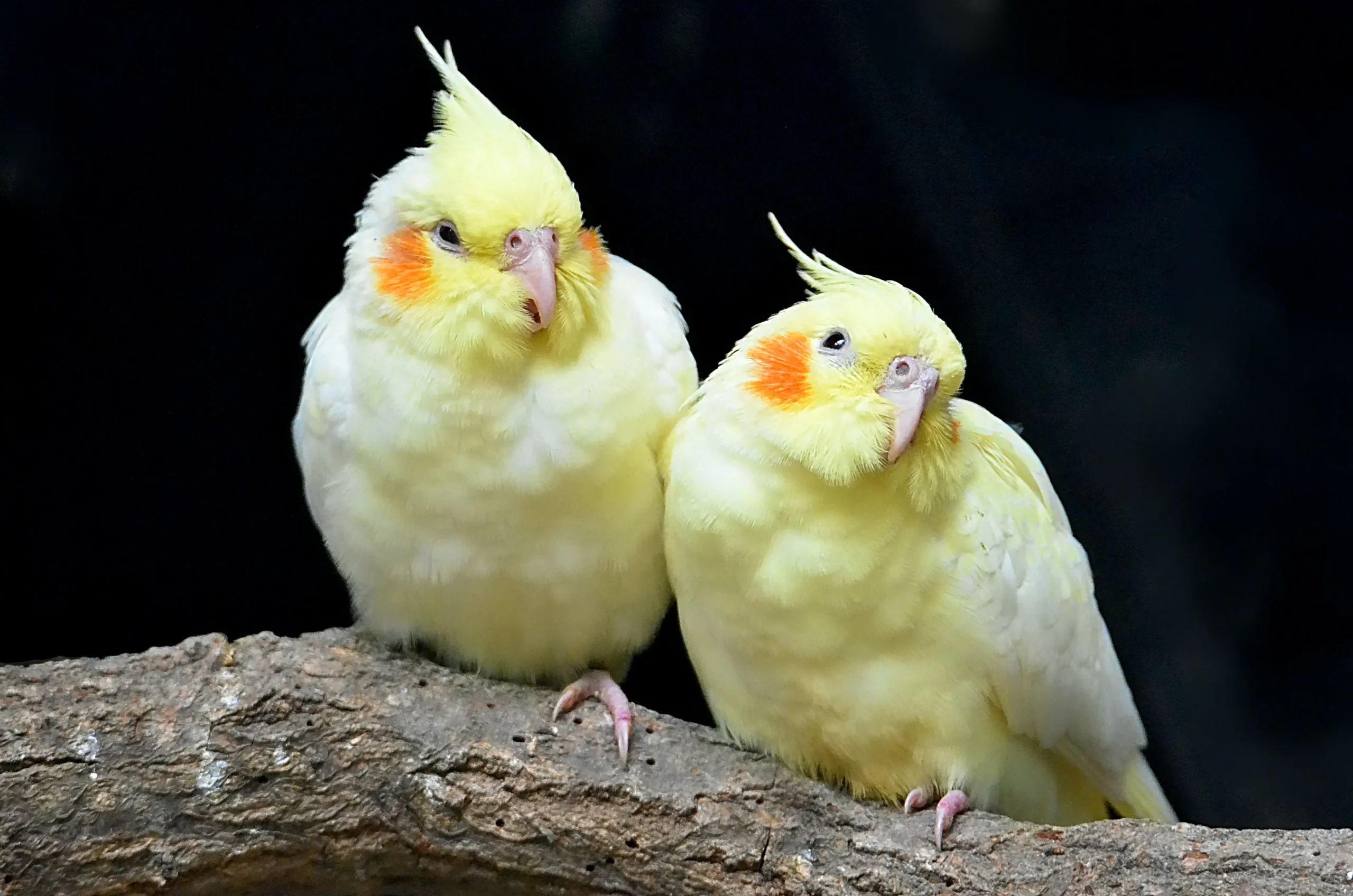
What Can Cockatiels Not Eat
Cockatiels should avoid foods that are high in fat, salt, sugar, caffeine, and additives. Additionally, foods that are toxic to birds, such as avocado, chocolate, and alcohol, should be strictly avoided.
Can Cockatiels See In The Dark
Cockatiels have limited night vision but are not adapted for seeing well in complete darkness. They rely on their hearing and other senses during low-light conditions.
Can Male Cockatiels Lay Eggs
Male cockatiel Birds cannot lay eggs. Only female cockatiels have the reproductive anatomy to lay eggs.
Do Cockatiels Need To Be In Pairs
Cockatiels are social birds that appreciate companionship. While they can be kept as single birds with sufficient human interaction, having a same-sex companion can provide mental stimulation and social interaction.
How To Trim Cockatiel Nails
Trimming cockatiel nails should be done carefully to avoid cutting into the quick (blood vessel). Use specialized bird nail clippers and trim only the tip of the nail, perpendicular to the nail’s growth.
Why Do Cockatiels Bob Their Heads
Cockatiel Birds may bob their heads as a natural behaviour. It can be a sign of curiosity, excitement, or even contentment.
Why Do Cockatiels Have Red Cheeks
The red or orange cheek patches on cockatiels are called “ear patches” and are used for communication and emotional expression. They can change in colour and intensity based on the bird’s mood.
Why Do Cockatiels Puff Up
Cockatiel Birds puff up their feathers to conserve warmth or to relax. It’s a natural behaviour that helps regulate their body temperature.
-
Do Cockatiels Like Music
Cockatiels may respond to music, especially if it’s calming or melodic. Some cockatiels enjoy singing along or moving to the rhythm.
-
How Many Days Cockatiel Eggs Hatch
Cockatiel eggs typically hatch after about 18 to 21 days of incubation. The female cockatiel is responsible for incubating the eggs during this period.
Recommended –

























